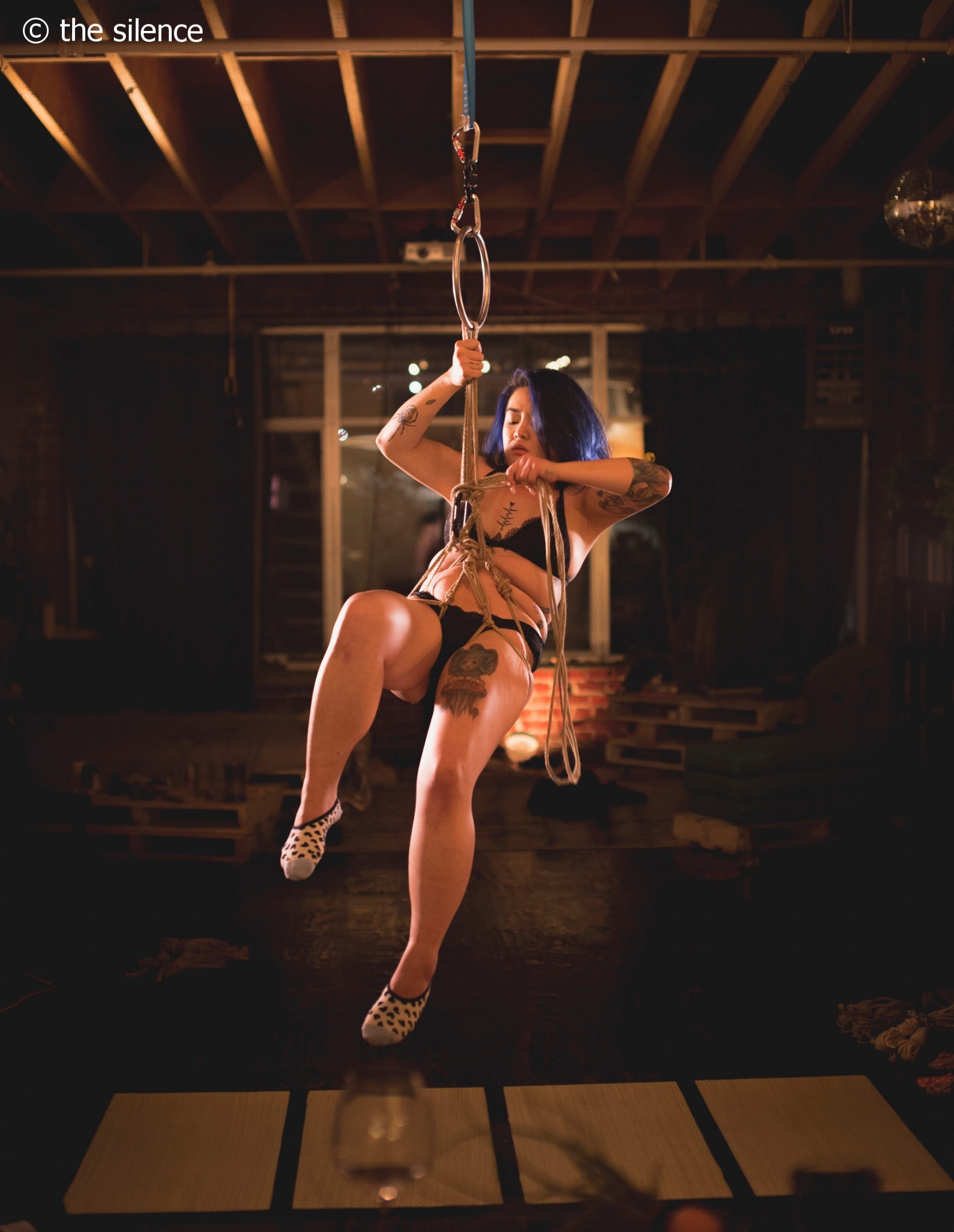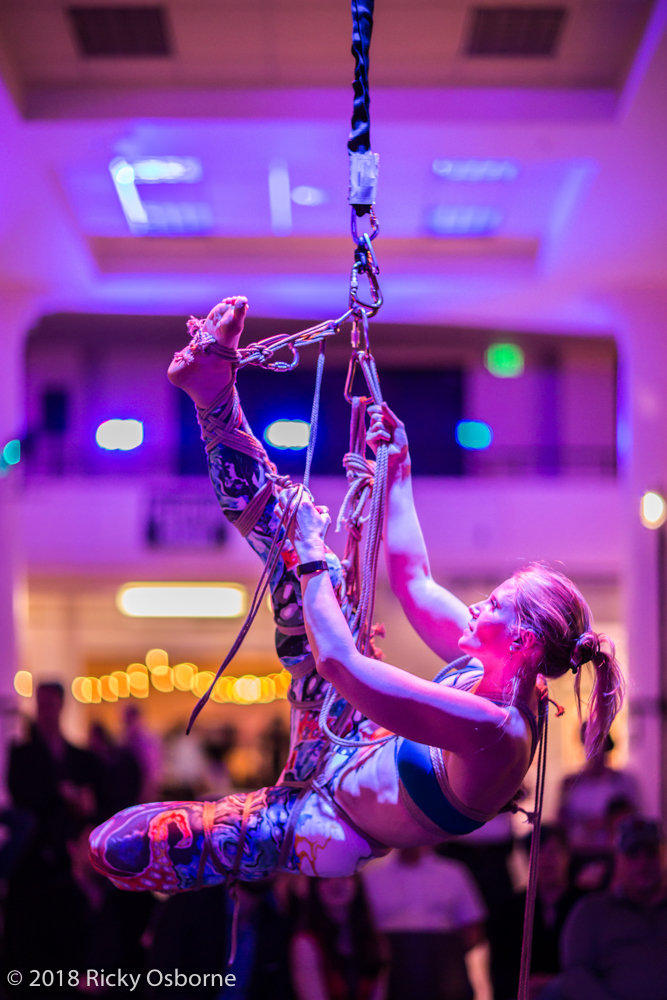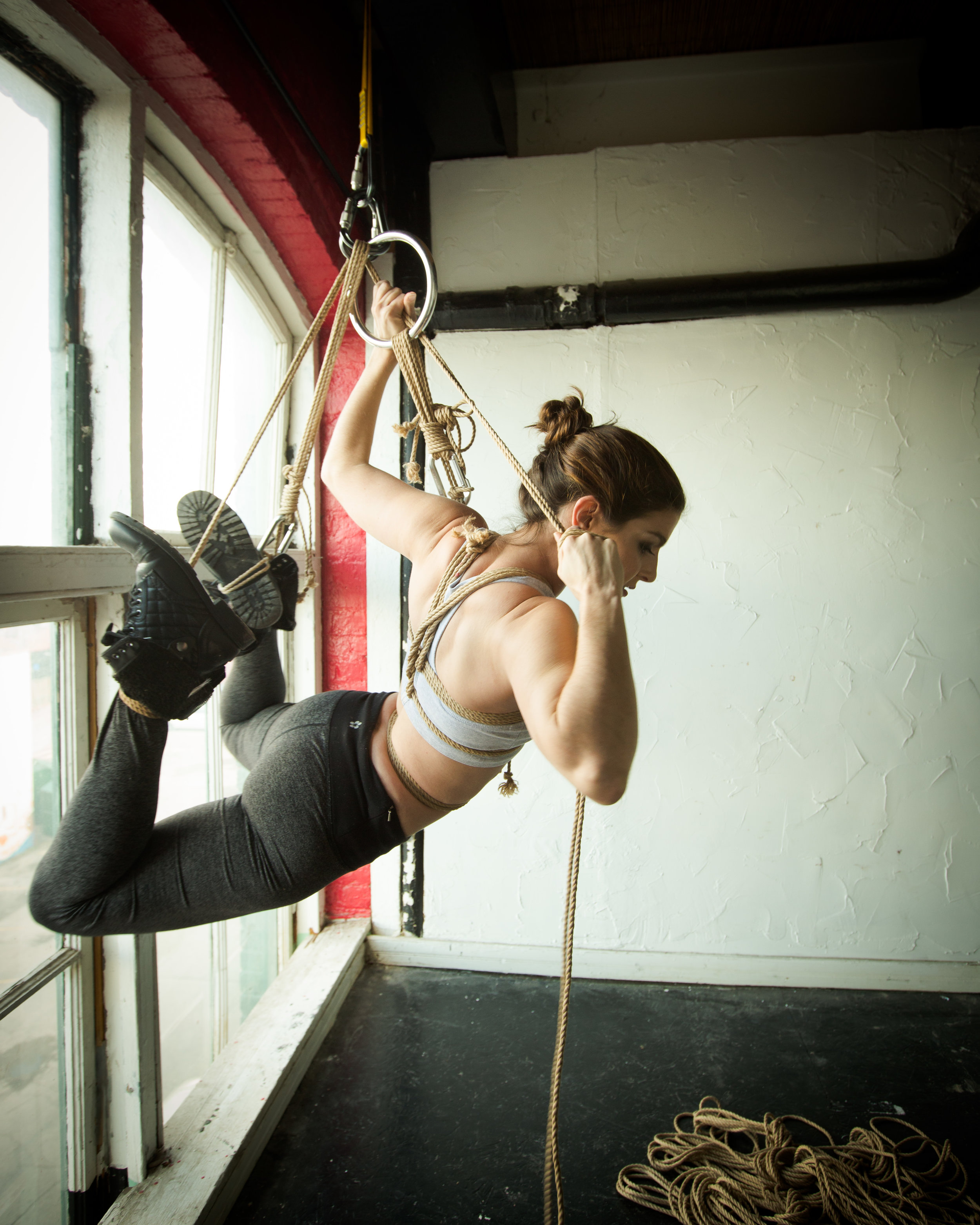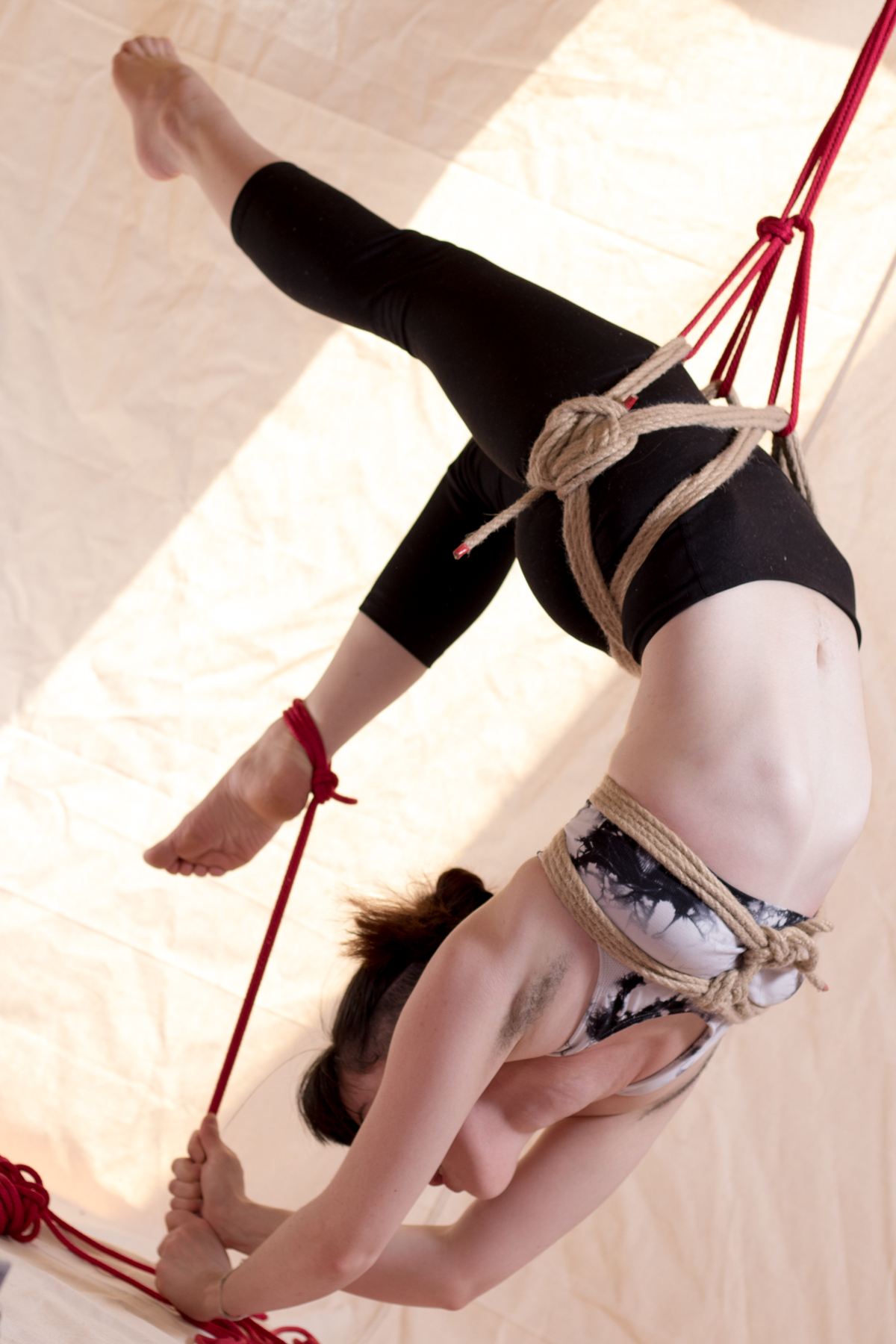





There is no “one true way” to do or experience rope. Self-suspension bucks more widespread or traditional archetypes of bondage in many different ways, and self-bondage aficionados face a number of unique challenges. There are as many different ways to practice self-suspension as there are self-suspenders – both challenge and opportunity exists within this huge variety.
This site is intended as a resource to give some perspectives on the background knowledge and practical, hands-on aspects of self-suspension, as well as the more philosophical aspects what we do and why. Use this site as a reference (along with mentoring and hands-on instruction) to help you learn this amazing skill, and grow your self-suspension practice from there.
Models/self-suspenders pictured on this site include Shay, Abbystract, nano_bites, Jade, Alicia T-Corn, Nikki_Darling, Honey_bare, WhiskyTangoFoxy, Marceline VQ, linworth, Kel Bowie, Hyena, StrangerFriend, Bombi, inthesilence, Angel666sub, Boatbabe, and Gabriel. Photo credit to Maestro Stefanos, Gabriel, The Silence, Honey_bare, Gary Mitchell Photo, ESP, WistfulThoughts, TaraChin, and Sin.
Shay Tiziano, the creator of this site, is also the author of the first-ever guide to self-suspension, Tying & Flying! This book takes a thorough and nondogmatic approach, including everything from meticulous safety information to practical step-by-step rope bondage instruction. Beautiful color photography with a diverse range of self-suspenders is featured throughout. Ebook and hard copy now available on Amazon!

Intention
Intention
Intention
StrangerFriend, photography by ESP.
Honey Bare
“Self-tying is when I get to express myself most with rope. I'm fully independent and the only constraints are my own limits, as both a top and bottom. It can be as inwardly focused or performative as I choose to make it, as restrained or dynamic. I push myself farther than I would push most bottoms, or than I would let most tops push me. Self-tying allows me to make a space for just myself.”—Abbystract
“I love to fly, I love pushing my body... basically, I self-suspend for the sheer joy of it.”—ANakedFlame
“I love rope because it becomes the intent you tie it with. Rope can encompass all of the things that make up my sexual kinky self: control, trust, submission, strength, self love, endorphins, endurance, intensity, aggression, pain, and joy.”—Phyllis
People who are unfamiliar with self-suspension often start by asking some variation on a basic question of intention: ”why would you do that… to yourself?” Or, as a dungeon passerby once inquired while I was in the middle of hanging myself from a single gravity boot: “What the hell are you doing to yourself?!?”
With anything we in kink, it's important to start with the “why.” For partnered play, intention is crucial to make sure you're meeting at the same place. If I think we're doing a highly connective rope scene to get in the mood for sex, and my partner thinks we're having some lab time so they can practice the new hip harness they learned, we are set up for a disastrous experience before any rope goes to skin. With unpartnered bondage, intention is no less important, and most people do many types of self-bondage scenes with multiple different motivations. Clarifying your personal “why” will help you know where to focus your training or learning, facilitate communication with your spotter, shape when and where you self-suspend, and help you give answers when people come to you with the inevitable question: “why?”
These questions come in part because even within the rope scene (and the kink community at large), self-suspension is very much an emerging practice. While it is still a small subset of What It Is That We Do (WIITWD), it’s been amazing to watch self-suspension expand exponentially over the past few years! I’ve been producing events in San Francisco since 2005, and in my first five years of hosting I saw all of two people doing self-bondage at my events. At a 2017 event, I saw five different people self-suspend! I’m seeing smaller-scale increases in self-suspension as I travel around the country to different kink conferences, as well—it’s fabulous to see this practice spreading and becoming more accepted in the kink community!

Beginning information
Beginning information
On the floor vs. in the air
“I find that the motivations behind self-bondage and self-suspension are the complete opposite. In self-suspension there's pride in one's achievement. In self-bondage there´s the desire to feel ashamed, to be degraded (if only by oneself).”—leaf-in-the-wind
It is common for folks in the bondage community to decry the “race to get in the air” and encourage people to spend a lot of time doing floor work before moving on to suspension. Certainly there is wisdom there — you need to be certain you have a solid foundation of body awareness, technical tying skill, and risk mitigation measures in place before attempting self-suspension. I personally spent over four years doing very simple “tie-me-up-and-fuck-me” style bondage before I started contemplating suspension!
With that said, it sometimes seems to me that the ways we measure “experience” can be pretty random. I’ve seen people with expertise in other types of aerial or rope practices (professional theater rigging, trapeze, silks, even sailing) progress rather quickly into self-suspension, and I embrace the perspective they bring to their bondage process. We don’t all start from the same place, and it’s ridiculous to proclaim that we should all follow an identical, prescribed path.
The floor work vs. suspension divide certainly exists in partnered bondage, but I think it is especially apparent in self-bondage. It’s been my experience that self-tying on the ground tends to be more explicitly sexual (frequently involving genital bondage, or done as part of masturbation), and often involves rather extreme immobilization and a humiliation angle. On the other hand, self-suspension is often more like training or performing on a trapeze, focused on exploring movement rather than immobility, with little direct sexual stimulation involved. Your mileage may vary – these are trends, not prescriptions (and certainly not judgements)! Suspension bondage and floor work can be rather different activities and may interest different people, at different times, and in different contexts.
All of this isn’t to say that people who are focused on self-suspension never do floor work – we do, whether just to practice a new futomomo or as an enjoyable stand-alone activity. But to think of it as a clean progression from floorwork to partial suspension to full suspension is a misconception, even more so to think people should "progress" through these types in certain prescribed periods of time.
You don't need to study with any particular Grand Poo-Bah of Bondage or spend a prescribed number of years tying on the ground before so much as glancing the direction of a suspension point. But the stakes go up once you lift off the ground, so you do need to be sure your fundamentals are there. If you can't tie an evenly tensioned hip harness or don't have awareness of your body's warning signs that you need to come out of a tie, you aren't ready to self-suspend. Enjoy every step of your bondage journey and don't rush yourself!
This web site is focused on self-suspension (rather than floor work), for the simple reason that it's written by a self-suspender who doesn't much like to tie on the ground. There are a few web sites focused on floorwork aspects of self-bondage, and I highly recommend checking those out as well!
Flow
“Self-suspension takes my anxiety, anger or sadness and dissolves every single feeling until it's only pain and focus on the knots.”—Hyena
My experience of self-bondage is often about getting into a flow state. The idea of flow originates with Mihaly Csikszentmihalyi, one of the pioneers of the scientific study of happiness. He defines flow as “a state in which people are so involved in an activity that nothing else seems to matter; the experience is so enjoyable that people will continue to do it... for the sheer sake of doing it.” – Flow: The Psychology of Optimal Experience
When I’m doing partnered bondage, I often have a hard time letting go of my brain chatter and worries. Self-suspension engages my mind and my body in a way that is quite unique and allows me to be fully present in the moment, mind and body working harmoniously.
The experience of “flow” is common in many other activities, including partnered BDSM. Most people have experienced it. Musicians might call it “getting in the groove,” athletes might say they’re “in the zone,” a writer might look at the clock and realize hours flew by while they were pouring words onto paper. In a flow state, you become entirely absorbed in what you’re doing, and feel "strong, alert, in effortless control, unselfconscious, and at the peak of [your] abilities." – Flow: The Psychology of Optimal Experience.
You likely won’t experience flow during your first few self-suspensions. It is a mental state that comes with practice and expertise, once you have established your skill to the point where you can act without conscious narration of every step of the process. This is one reason to drill the basics until you can execute them smoothly without much conscious thought.
More on intention
“I enjoy self-suspension for its own sake, much like masturbation is a completely different experience from partnered sex.”—Azura Rose
“Mostly I self-tie to get exactly the rope that I want, when I want. I don't like to micromanage my tops, but I also crave very specific sensations, positions, etc. There is a feeling of power and autonomy to satisfying my own needs that makes self tying a very beautiful experience for me.”—Cozima
“I've had people assume that I'm self-tying because I don't have anyone to tie me, which makes far too many incorrect assumptions about me.”—Abbystract
Using self-tying as a stop-gap when a partner isn’t available is a common way that people think about this activity, but it’s important not to conceive of self-tying only as a thing people do when there’s no one around to tie them. I, and many other self-suspenders, often prefer to self-tie, even when there is the option of partnered tying.
Some of the reasons people might prefer self-suspension to being suspended by a partner (at least sometimes) include:
Freedom to set your own pace, explore, and satisfy yourself without feeling the need to please and perform for a partner
Desiring a very specific type of rope experience (“I want to start in a side suspension and transition to a right leg futomomo, spin around until I’m tired, and come down.”)
Wanting a physical challenge or a “rope workout”
Fitting a “rope fix” into a short and specific window of time that isn’t long enough for a partnered session
Practicing ties (“rope science” or “lab time”)
Learning about rope bottoming
- Challenging yourself or simply adding more variety to the way you experience rope
Performing at Seattle Erotic Art Festival. Leggings from here (supporting an awesome independent artist)!

Gallery
Gallery
Gallery
Photographs of some amazing & beautiful self suspenders to inspire your journey!
WhiskyTangoFoxy
Hyena, photo by WistfulThoughts
Honey_bare
linworth, photo by Gary Mitchell
Marceline VQ, photographer TaraChin
Gabriel, photo by Shay
Abbystract, photo by The_Silence, taken at Twisted Windows
Door2nothing, photo by Stefanos
Alicia T-Corn, photo by Stefanos
Kel Bowie, photo by The Silence, taken at bondage performance event Twisted Windows
inthesilence and Angel666Sub
nano_bites, photo by The_Silence
Lexy T-Corn, photo by Stefanos
Bombi
Marceline VQ
Gabriel
Boatbabe, photo by Shay
Alex T-Corn, photo by Stefanos at the SF Self-Suspension Open Space
StrangerFriend, photography by ESP.
WhiskyTangoFoxy
Kel Bowie, photo by FANFetica Photography
Hyena, photo by WistfulThoughts
linworth, photo by Gary Mitchell
Rage_Tits_McGee, photo by Stefanos at the SF Self-Suspension Open Space
Squeeks, photo by Stefanos
Bombi
ViolaSlut and Door2nothing, photo by Stefanos at the SF Self-Suspension Open Space
Strangerfriend, photo by mindfullove
MissBaston at the SF Self-Suspension Open Space, photo by Shay
Angel666Sub, inthesilence and tinx. Photo by modelnotonfet





































